
Technophobia! Author: Published by:
|
 |
|
Technophobia!
Introduction:
Dreams of Techno-heaven – Nightmares of Techno-hell
"Computing power, neuroscience and nanotechnologies are advancing so rapidly that they will combine to produce the most significant evolutionary developments since the origin of life itself. . . . . Imagine yourself a virtual living being . . . free of physical pain, able to repair any damage and with a downloaded mind that never dies."
--Gregory Paul & Earl Cox, Beyond Humanity
"We gave birth to AI . . . a singular consciousness that spawned an entire race of machines. We don’t know who struck first - us or them - but it was us who scorched the sky. Human beings are no longer born, they are grown. You are a slave, you were born into bondage."
--Morpheus, The Matrix
Techno-Heaven awaits you. You will be resurrected into posthuman immortality when you discard your body, digitize your mind and download your identiy into the artificial brain of a computer. Cyber-existing in virtual reality, you will live forever in a perfect simulation of divine bliss. This techno-heaven is envisioned by a cult of techno-priests – scientists and their apostles - who profess a religious faith that the god technology will eliminate the pain and suffering of humans by eliminating humans. These techno-utopians fervently believe that technological progress will lead to perfection and immortality for the posthuman, cyborg descendants of a flawed, inevitably extinct humanity. Is this a happy dream or a dismal nightmare?
In contrast to this bright vision of a pain-free, posthuman techno-heaven, science fiction frequently paints a dark picture of technology. From the destructive robot-witch of Metropolis (1926) to the parasitic squid-machines of The Matrix Revolutions (2003), the technologized creatures of science fiction often seek to destroy or enslave humanity. Science fiction shows the transformation into the posthuman as the horrific harbinger of the long twilight and decline of the human species. In its obsession with mad scientists, rampaging robots, killer clones, cut-throat cyborgs, human-hating androids, satanic supercomputers, flesh-eating viruses and genetically mutated monsters, science fiction expresses a technophobic fear of losing our human identity, our freedom, our emotions, our values and our lives to machines. Like a virus, technology autonomously insinuates itself into human life and, to insure its survival and dominance, malignantly manipulates the minds and behavior of humans.
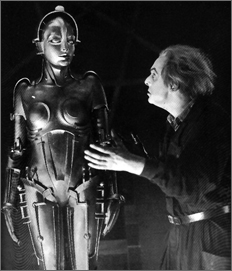
This book explains the dramatic conflict between the techno-utopia promised by real world scientists and the techno-dystopia predicted by science fiction. Such technophobic science fiction serves as a warning for the future, countering cyber-hype and reflecting the real world of weaponized, religiously rationalized, and profit-fueled technology.
The United States’ 2003 invasion of Iraq offers a suggestive example of autonomous technology supported by religious, military and corporate interests. An expansion of the American Techno-Empire, the invasion’s security rationales – Iraq’s nuclear threat, their huge stores of chemical and biological weapons, and their ties to the September 11 terrorists – all proved wrong. Falsehood was expressed as certainty by the Bush administration who fabricated, exaggerated and distorted the pre-War intelligence to justify the war. With the bloody horror of its dead and wounded hidden, the invasion appeared - in the American media – as advertising hype for U.S. military power and technology. Human costs were minimized. Battling a technologically-primitive enemy, the war was a techno-slaughter test of America’s latest bombs, guns, and planes. Even more insidiously, the invasion can be seen as a war to seize control of the oil needed by the machines. In this sense, humans have been subsumed into weaponized systems and themselves function as the slave-like tools of technology. Technological imperatives propel war and the politics of domination.
As American warfare has become more and more technologically driven, scientific, corporate and military interests have become inseparable. Much of the research and development of 21st century posthuman technologies, such as artificial intelligence, nanotechnology and robotics, were originated and funded by the American military often through the Defense Advanced Research Projects Agency (DARPA). Created in 1958 to avert a weapons gap with the Russians and inspired by their launching of Sputnik, DARPA – which currently disburses nearly $2 billion annually to corporate, government and university researchers – remains America’s most powerful force driving technological change through weapons development.
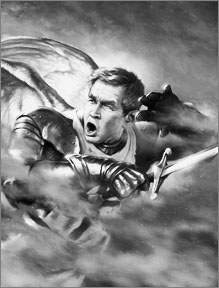
Aligned with weaponized technology, corporate profit and religious propaganda, President George Bush – an evangelical Methodist - pledged a “crusade” to “rid the world of evil-doers,” a phrase that sounds like a call to battle against satanic forces; thankfully for the petroleum companies, Satan happens to reside on Iraq’s rich oil reserves. The war, like the science fiction to be discussed in this book, dramatizes a disturbing aspect of technology: it is energized by a deadly alliance of military, corporate, and religious interests. Promoting a religious vision of technology, the evangelists of techno-heaven promise the reward of everlasting life in exchange for subjugation to the machine.
Transferring human minds into death-free robots, according to artificial intelligence expert Raymond Kurzweil, will produce the next stage of evolution –- an immortal machine/man synthesis: Robosapiens. While this sounds like science fiction, Kurzweil - in his 1999 book The Age of Spiritual Machines- expresses it as inevitable science fact. Calling this evolutionary transformation “The Singularity,” mathematician and science fiction writer Vernor Vinge believes that the result might be the “physical extinction of the human race.” Echoing Vinge and Kurzweil, robotics pioneer Hans Moravec forecasts a utopian, robot-dominated, postbiological future in his book Robot: Mere Machine to Transcendent Mind (1999). From a biotechnological angle, Gregory Stock in Metaman: The Merging of Humans and Machines into a Global Superorganism (1993) predicts the genetic re-engineering of the species for posthuman perfection.
Posthuman evolution –- the development of human/machine fusion –- is clearly underway. Tiny cameras, serving as artificial eyes, wired directly into the brain; mechanical hands and legs controlled by nerve impulses; computer networks populated by disembodied minds – all these blur the distinction between human and machine. The mapping of the human genome bestows unprecedented, almost-divine power on biotechnologists who want to create superhumans by re-tooling evolution and genetically reconstituting the species. While we wait for brain implants to make us smarter, nanotechnologists will engineer intelligent molecular machines and inject them into our bodies to destroy diseases before they terminate us. Meanwhile, self-reproducing nanobots will revolutionize the economy by providing an abundance of cheaply-made replacement organs, material goods and food. Taken collectively, 21st century technologies –- Robotics, Artificial Intelligence, Bionics, the Internet, Virtual Reality, Biotechnology and Nanotechnology - promise a new era in human progress, the Posthuman Age. While this book is about science fiction, it includes a brief history and status report on these technologies as we explore imaginings of their future possibilities and the risks they entail.
The rapid development of posthuman technologies – according to the requirements of war and profit - will have profoundly disturbing, perhaps revolutionary effects on our world. If we are approaching a dangerous threshold of posthuman evolution, or Singularity – a twilight zone where “ . . .our old models must be discarded and a new reality rules,”science fiction helps us envision that new reality. The best science fiction extrapolates from known technology and projects a vision of the future against which we can evaluate present technology and its direction. The main premise of this book is that science fiction matters, that the actual development of technology and our response (or lack of response) is influenced by popular culture. Drawing a vision of the future from attitudes, moods and biases current among its artists and their audience, science fiction not only reflects popular assumptions and values, but also gives us an appraisal of their success in practice. Alone, cultural imagery and themes do not motivate behavior. But recurring images and themes reveal behaviors that are culturally valued while advocating a point of view for discussion. Science fiction serves as social criticism and popular philosophy. Often taking us a step beyond escapist entertainment, science fiction imagines the problematic consequences brought about by these new technologies and the ethical, political and existential questions they raise.
As emerging technologies shift the balance of power between human and machine, our concept of humanity alters. Rapidly accelerating computer intelligence joins an escalating series of ego-smashing, scientific breakthroughs that diminish human self-image. Copernicus pushed us from the center of the universe; Darwin linked us to apes, slugs and bacteria; Freud showed us that we often do not control our own minds. Computers now threaten to surpass us in intelligence. Cyborgs are stronger and more powerful. Clones portend an unlimited supply of duplicate selves. This reduces the value of our own minds, bodies, individuality and consciousness. A kind of evolutionary panic ensues, giving rise to fears of being transformed or taken over by machines. These fears are amplified by military and corporate funding of emerging technology, insuring life-threatening and profit-making developments without regard to ethical or human consequences. As Langdon Winner says in Autonomous Technology (1977), “Technology is a source of domination that effectively rules all forms of modern thought and activity. Whether by an inherent property or by an incidental set of circumstances, technology looms as an oppressive force that poses a direct threat to human freedom.“ Science fiction taps into these existential fears while reinforcing our concerns about the misanthropic humans who serve as technology’s collaborators in domination.
In my analysis, Winner’s concept of autonomous technology - which develops Jacques Ellul’s radical critique in The Technological Society (1964) - serves as a theoretical touchstone. Beyond this, I will show how science fiction anticipates and reflects recent warnings about technomania. Bill Joy's widely read 2000 article in Wired "Why the Future Doesn't Need Us" splashed cold water in the face of technocrats with its incisive warning about the dangers that robotics, genetic engineering, and nanotechnology pose to humanity’s survival. Coming from Sun Microsystems’ chief scientist, co-creator of the Unix operating system and developer of Java software, Joy’s stinging rebuke was all the more painful to technologists who believed he shared their faith. He called attention to technology’s “unintended consequences” while evaluating the techno-vision of everyone from the neo-Luddite Unabomber to robotics posthumanist Hans Moravec, taking seriously the likelihood that machines will supplant humans as the dominant lifeform on the planet. He singled out the most dangerous aspect of these technologies – self-replication, an issue explored in the oldest science fiction novel, Mary Shelley’s Frankenstein (1818), and in contemporary ones, like Michael Crichton’s 2003 best-seller Prey.
After providing a contemporary and historical context for the treatment of technology in science fiction, I will use individual chapters to focus on particular types of technological posthumans including robots, computers, androids, cyborgs, and clones. In this way, I will examine concerns surrounding specific technology, rather than a general demonizing, and make connections between individual types of technology and webs of social and political influence. Within each chapter, I will argue specific links between technology, religion, military and corporate science and show how this conglomerate of techno-interests helps motivate popular culture’s pessimistic evaluation of technology’s impact on our lives. Out of this will grow a focused perspective on the most important question of the 21st century: Is technology out of control? Science fiction helps focus the debate as it plays out potential implications of uncontrolled technological development. Of course not all science fiction is technophobic and not all scientists serve military and corporate interests, just most.
Unlike other science fiction studies, the scope of this book includes film, television, literature and computer games. My dominant focus is cinema, but I delve into the other media when it suits my aims. The vast literature of science fiction is daunting. Trying to read everything would confuse or kill me if not limited by some purposeful or even arbitrary standard. Avoiding most short stories, I limit myself to historically significant novels (deemed as such by me or others I admire) as well as books that have won one of the chief science fiction awards: Hugo, Nebula, Philip K. Dick and Arthur C. Clarke Awards.
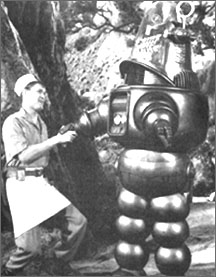
Before briefly summarizing each chapter, I want to make some brief comments about terminology. Cyborgs are not robots or androids. Robots consist of mostly mechanical and electronic components. Usually resembling a human or animal, a robot comes in any size – the term includes everything from the clanging metal man of the 1950s, like Robby in Forbidden Planet, to humanoids like David in A.I. Artificial Intelligence (2001). Androids can be robots that look human - like Star Trek’s Data - or genetically engineered, wholly organic humanoids - like the Blade Runner replicants; but androids do not combine organic and inorganic. A cyborg, or cybernetic organism, combines the biological and mechanical and may or may not look identical with a human – the Terminator looks human until his skin gets burned off, then he looks robotic. Possibly because the composition of a fictional artificial person is not always known precisely, these terms remain somewhat nebulous and interchangeable. Finally, the book’s title “Technophobia” is meant to suggest an aversion, dislike, or suspicion of technology rather than an irrational, illogical or neurotic fear. I want to elevate the term beyond its derisive dismissive use by rabid technophiles who believe that questioning technology’s direction is crazy if not satanic.
Chapter One: Technology is God contends that the prophets of posthumanism preach “Technologism” – the religion of technology. The positive promise of human-improving techniques and the God-like power they confer lead many self-proclaimed, posthuman visionaries to elevate technology to divine status. Rooted in religious myth with its own dogmas, doctrines, prophecies, sacraments and priests, this fundamentalist techno-theology evokes faith, devotion and awe as well as religious promises of perfection and immortality in heaven. Techno-prophets such as Kurzweil and Moravec believe humanity will be resurrected into posthuman immortality on the electronic wings of its machines. Like their Christian and Gnostic forefathers, the prophets of our techno-future reject the organic body and view technology as salvation from that death-susceptible host of our potentially eternal mind. They promote the abandonment of flesh, blood and bones to the electronic circuitry of our mechanistic progeny. They predict that humans will themselves become electronic gods who have downloaded their minds into robotic technology, cast off their diseased bodies, and cyber-exist forever in a virtual reality of disembodied perfection and simulated bliss.
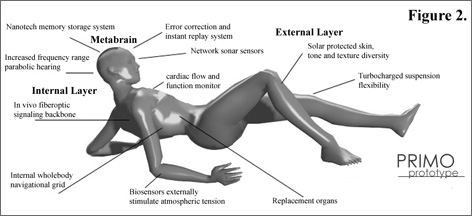
Meanwhile, the technology of genetic manipulation will improve the bad design of our species as well as other living things. According to biotechnology advocate Gregory Stock, in his book Redesigning Humans (2002), God-like genetic engineers will seize control of evolution - encouraged by the commercial potential of genetically enhanced children - to evolve some of us (the richest ones) into super-humans with higher intelligence, bigger memories and longer lifespans. Nanotechnology prophet Eric Drexler promises that artificially intelligent, molecular machines will be injected into our bloodstreams to diagnose and repair problems. The miraculous enhancement-power of these technologies provide techno-utopians with a dream of perfection.
Chapter Two: Haunted Utopias argues that the religious vision of a techno-utopian future - inhabited and engineered by artificially intelligent robots, androids, cyborgs, clones and super-people - derives from an ancient fascination with machine-based religious utopias and mythical artificial humans. The early utopian imagination – such as in Francis Bacon’s New Atlantis (1627) - propelled and embraced technological development with little cultural criticism. Humanity put its faith in progress, the goodness of man and the positive impact of science. The whispers of techno-resistance - that have recently risen to a scream – were not much heard until the 1818 publication of Mary Shelley's Frankenstein, or The Modern Prometheus.
Underpinning the rise of the machine was the ascent of science and the quasi-religious myth of progress. The 17th century mechanistic philosophy of Rene Descartes along with the empirical method of Francis Bacon combined to produce scientific rationale and methods that intertwined with religious, political and utopian thinking. Thus began the techno-hype that linked technology to religious myths of heaven. “The optimistic atmosphere of the 18th century . . . created a climate favorable to the rise of technical applications,” says Jacques Ellul in The Technological Society (1964). “This state of mind created a good conscience on the part of scientists who . . . believed that happiness and justice would result from their investigations; and it is here that the myth of progress had its beginning.”But the dark side of the industrial revolution combined with the mechanized cataclysm of World War I engendered a cultural counter-force - powerful anti-science visions and technophobic fiction such as Fritz Lang's film Metropolis (1926), film adaptations of Frankenstein in 1931 and 1935, and Aldous Huxley's novel Brave New World (1932). These dystopian works sounded a warning alarm, revealing problems overlooked by blind technological obsession. Delving into the history of mechanical invention, artificial humans, utopian visions and dystopian fears will reveal some of the icons, myths, and mystical themes that underpin the modern, techno-religious vision of science as well as the earliest resistance to its lure.
Chapter Three: Cybernetic Slaves examines the dawning of the robot age, the rise of cybernetics and a pop culture schism in the evaluation of technology’s role in human life. A hybrid of philosophy, linguistics, mathematics and electrical engineering, cybernetics – a new vision of techno-perfection - set off the first chorus of cyber-hype about the ultimate power and value of computers. While evoking religious faith in science, the inventor of cybernetics Norbert Wiener warned, in The Human Use of Human Beings (1950), of the danger in ceding control of moral judgement to machines. Shortly after Wiener delivered his warning, author Kurt Vonnegut Jr. published an anti-cybernetic novel. Player Piano (1950) projected a world where automatons do everything, resulting in a techno-tyranny ruled by machines and their slaves – button pushers, office bureaucrats and corporate managers. As Theodore Roszak says in The Cult of Information, Vonnegut raised “ . . . the issue of whether technology should be allowed to do all that it can do, especially when its powers extend to the crafts and skills which give purpose to people’s lives.”
As a science, cybernetics mutated into robotics and artificial intelligence; as an ideology, it provided the springboard for contemporary visions of an earthly technological heaven. Cybernetics also served as the scientific basis for science fiction writer Isaac Asimov's 1950s backlash against the technophobic vision implicit in the killer robots of gothic-inspired science fiction.
Simultaneously with the ascent of cybernetics, nuclear technophobia raged as gigantic radioactive monsters, like the mutated ants of Them (1954), lumbered across America’s movie screens. Providing a positive alternative to the created-by-science monsters of the atomic horror film and the sinister robots of the science fiction pulp magazines, writer Isaac Asimov in I Robot (1950) – adapted into an un-Asimovian 2004 movie - presented a method for insuring good robots. His Laws of Robotics demonstrated a cybernetic guarantee that obedience and servitude would be programmed into robot technology, a general vision of technological safety still employed today.
Yet, even with benevolence programmed into their systems, robots killed with kindness in Jack Williamson’s 1948 short story “With Folded Hands” while automatic factories, that can’t be shut off, destroy the environment in Philip K. Dick’s 1955 story “AutoFac.” Ridiculing claims of human mastery through cybernetic perfection, the technophobic impulse finds expression in not only the unforeseen consequences of mutated nuclear monsters but with machines so inflexible in their programmed agenda that an initially positive benefit turns into a human-threatening, techno-tyranny.
Chapter Four: Machines Out of Control explores the rise of artificial intelligence and its links to religious, military and corporate power. Increased concern about the dire consequences of A.I. is reflected in science fiction supercomputers and programmed androids that revolt against their human creators. These deranged computers and enraged androids grew out of the weaponization of artificial intelligence and the sense that technology incorporated the negative as well as the positive characteristics of humanity. Thinking machines confront us with a repulsive incongruity more disturbing than the horror of a stitched-together, reanimated humanoid. Artificial intelligence flirts with the mysteries of the mind and reduces thinking to mere mechanics while potentially threatening the existence of the human species. Initially associated in the public mind with the military and the atomic bomb, artificially intelligent supercomputers turned into human-hating science fiction monsters that wanted to enslave or kill humans and inherit the world.
The tiny silicon chip propelled our robotic technology into posthuman overdrive, as powerful computers began to inhabit the bodies of mobile robots. With computers getting smaller, faster, and more powerful every year, Kurzweil extrapolates this information to predict that the computational power of a computer will surpass that of the human brain in 2020. But what will happen then? Will humans passively watch as they are surpassed by a new species or will they battle for their survival? Or, as the techno-prophets predict, will humans fuse themselves into machine-symbiosis by downloading their identities into the mechanical brains of immortal robots? Science fiction addresses these questions, while using the robot or android as a metaphor to analyze the nature and worth of humanity.
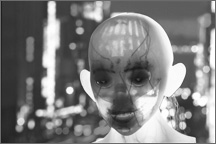
Chapter Five: Rampaging Cyborgs extends the science fiction argument against techno-obsession to the bionic fusion of cybernetic device and biological organism which may produce a new and improved cyborg body but may also produce a weapon. The replacement of our flesh and blood with mechanical augmentation subtly blurs the definition of what constitutes a human body and encourages a dream of immortality. While technoscience projects a bionic vision of posthuman perfection, the cyborg was born as an astronaut and a weapon. The earliest imagining of the cyborg, in the 1960s, involved a never-implemented military plan to surgically and pharmaceutically modify the bodies of astronauts for space travel. At the same time, the military evolved the cyborg in the development of man-machine interfaces, such as between pilot and jet, that structure modern weapon systems. This helped set the stage for the cyborg’s earliest fictional incarnation in the novel Cyborg (1972) by Martin Caidin - which centers on a crashed test pilot whose damaged body gets machine replacement parts.

By the 1980s, the science fiction cyborg had become a ubiquitous icon of pop culture, reflecting its increasing importance. These machine people ranged from the scarcely organic Terminator and the castrated, mostly mechanical Robocop to the tough virile Bionic Man and sexy gal pal Bionic Woman; from the alien/human/machine cross-breed Ripley in Alien Resurrection to the human-hating Borg of Star Trek; and from the plugged-into-virtual reality savior of humanity in The Matrix to the genetically enhanced Valids of Gattaca. The melding of the organic and the mechanical, the organic and the alien or the engineering of a union between separate species, cyborgs also include American Iraq-War pilots integrated into a cybernetic weapon systems as well as suicidal terrorists who merge with technology to transform themselves into human bombs.
Science fiction cyborg stories dramatize our fears as we become targets in the world of cyborg weapons, while anticipating the demise of the flesh and blood body and the gradual extinction of humanity. "There is, underlying these works, an uneasy but consistent sense of human obsolescence," writes Scott Bukatman in Terminal Identity (1993), "and at stake is the very definition of the human."While the machinic replacement of lost body parts enhances the lives of disabled people, the sheer number of monstrous cyborgs reflects a pervasive anxiety that our technological lust will propagate grotesquely deformed, superhuman techno-creatures that will ultimately extinguish us.
Chapter Six: The Infinite Cyberspace Cage focuses on the internet and virtual reality as facades of freedom that often serve as weapons of surveillance and mind control. Like most of the technologies examined in this book, cyberspace technologies were originally launched by the military. As early as the 1940s, virtual reality systems arose for use as cheap training for both bomber pilots and tank drivers. The internet got its start in the 1960s as a network designed to link the computers of defense department contractors and, some hoped, to serve as a nuke-proof communications system. The concept of cyberspace derives from William Gibson's famous 1984 novel Neuromancer. Brain-implanted cyborgs plug directly into massive data networks, visualized as an abstract, alternative virtual world. When Neuromancer came out, personal computers had just started invading homes while internet and virtual reality technologies were little known publicly. Gibson’s vivid, strange and frightening near-future tales of cyberspace cowboys, weaponized cyborgs, underground genetic surgeons, and evil multi-national corporations struck a deep cultural chord.
Neuromancer, along with the movies Blade Runner (1982) and Videodrome (1982) helped spark cyberpunk - a power-surge of intensely dystopian science fiction by such authors as Pat Cadigan, Rudy Rucker and Bruce Sterling. Cyberpunk science fiction elaborated alternative visualizations of cyberspace, explored the posthuman figure of the cyborg, and influenced pop culture in the late 1980s and early 1990s. Mondo magazine spread the graphics and the word while the industrial rock scene - bands like Frontline Assembly, Front 242, Nine Inch Nails, Skinny Puppy, Marilyn Manson, and Ministry- reflected cyberpunk's dark, techno-rebellious style with tortured angry lyrics, sound samples of political/cultural detritus, fast aggressive machine-based music and cyborgian imagery. In science fiction films, cybernetically enhanced existence shifted from rampaging, muscle-bound macho cyborgs epitomized by Arnold Schwarzeneggar to skinny, mind-expanded cyberpunks epitomized by Keanu Reeves.
Techno-utopian network idealists predict that the internet will fuse with virtual reality such that websites will function as life-enhancing alternative realities where the mind flourishes, flesh expires and happiness beckons. As digital cyber-spirits, we would program sensory experiences that simulated entertainment, pleasure and happiness. As Gregory Paul and Earl Cox describe cyber-heaven in Beyond Humanity (1996): "All senses will be fully engaged - vision, hearing, smell, touch. Your dream body will feel as real as a real body. . . . Cybersex will be performed in the realm of cyberfantasy . . . a virtual experience will seem just as real and even more enjoyable [than real sex]."
Science fiction, however, frequently views cyberspace as a dangerous trap. From the manipulative, virus-like artificial intelligences that prowl the networks of Neuromancer and the 1982 movie Tron to the extremes of surveillance in Neil Stephenson's novel Snow Crash (1992). Making mind control literal, artificially intelligent machines use virtual reality to imprison humans in Andy and Larry Warchowski’s movie The Matrix (1999). In The Matrix, the real turns out to be illusion, but in movies like Virtuosity (1995) and David Cronenberg's eXistenZ (1999), cyberspace illusion becomes reality. With the body as the interface and the brain as a computer, the human becomes a machine trapped in an inescapable cage.
Chapter Seven: Engineered Flesh examines biotechnology - genetic engineering, eugenics, and cloning. Rather than enhancing the body by replacing flesh with machine, biotech high priests want to perfect the body through genetic manipulation. Of all the technologies discussed in this book, these biology-based ones encourage the most current debate, passion and controversy because of their powerful impact and imminence. Advances in genetics that diminish disease and suffering should be encouraged. Yet we fear that genetic engineering’s quest to improve will turn dark."More than other cyborg technoscience, genetics foregrounds the issue of human versus posthuman," says Chris Hables Gray in Cyborg Citizen. "Genetics offers the most likely, and most effective way, of using artificial evolution to produce intelligent nonhuman creatures.”
Since the birth of the genetic revolution in the 1970s, bioethicists, scientists, politicians, and artists have struggled with immense questions: Should children be genetically engineered for intelligence, good looks, athletic ability, musical inclination or any other traits? Will only a rich elite benefit from this technology, thus producing an enhanced superhuman class or species? Does that matter? Should corporations be allowed to own and profit from human genetic information? How can we anticipate and avert dangerous consequences? Should we regulate any aspect of the technology and, if so, how? The controversy spawns widespread debate in books such as Redesigning Humans: Our Inevitable Genetic Future (2002) by Gregory Stock, Enough: Staying Human in an Engineered Age (2003) by Bill McKibben, The Terrible Gift: The Brave New World of Genetic Medicine (2002) by Rick Carlson and Gary Stimeling, and Our Posthuman Future: Consequences of the Biotechnology Revolution (2002) by Francis Fukuyama. Testifying to the impact of science fiction, all of these works cite Alduous Huxley's Brave New World and the latter two employ it as an extended metaphor to bolster their anti-technology arguments. Huxley’s novel has become a dominant motif in discussions of the biotechnological future.
Public interest in these technologies grew rapidly in the 1990s, especially after the 1996 cloning of the sheep Dolly and the 1999 completion of the Human Genome Project. Jurassic Park (1993), with its rampaging cloned dinosaurs, became one of the most popular films ever. Both the movie and the Michael Crichton novel upon which it was based explore the problem of ego-mad geneticists, who work for profit-driven corporations and give no thought to ethics or the potentially disastrous consequences of their tinkering with evolution. Extrapolating on the principles of genetics, biological science fiction questions the weaponized use of the technology, the unforeseen consequences of transgenic experimentation, the morality of human cloning and the eugenic desire to perfect humanity by controlling evolution.
Chapter Eight: Malevolent Molecular Machines explores the threat and promise of nanotechnology – theultimate fusion of biological and informational sciences. The high priest of nanotechnology, Eric Drexler spread his ideas to the public in the 1986 book Engines of Creation: The Coming Era of Nanotechnology. In Drexler’s exalted view, atomic manufacturing will give scientists the God-like power to structure matter and recreate nature. He argued that nanotechnology – through programmed, self-replication - will give us the ability to produce almost anything: cars, dogs, drugs, tools, tables, computers, hamburgers, and houses. Factories will become obsolete. Aside from all this, artificially intelligent nanobots will be injected into our bloodstreams to detect and cure diseases before they hurt us. While the nano-revolution, like all 21st century technologies, promises heaven on earth for posthuman cyborgs, it also brings threats and risks. Science fiction helps us to envision possible consequences.
Set in the nanotechnology industry of the future, Blood Music (1983) by Greg Bear predates Engines of Creation and dramatizes human-destroying consequences of self-replicating nano-machines. Weaponized nanotechnology and its all-pervasive surveillance and mind-control capabilities are projected in Paul McAuley’s Fairyland (1995) while Neal Stephenson’s The Diamond Age (1995) envisions a tyrannical society under total nano-control that gets overturned by human love. As the ultimate synthesis of posthuman technologies and the least developed, nanotechnology offers science fiction the greatest opportunity to play out unforeseen consequences in time for us to ask serious questions about its direction and value.
Chapter Nine: Technology is a Virus brings the book full circle with science fiction’s answer to the transhumanist faith that Technology is God. Biological and electronic viruses - while reflecting real world fears of infectious disease – also can be viewed as a potent metaphor for techno-anxiety. The force that can destroy both humans and posthumans, the virus also functions as a symbol of oppressive techno-politics as well as corporate, military and scientific irresponsibility.
Mad science, in collusion with its corporate and government sponsors, gets denounced in the gigantic parasite film Alien (1979), David Cronenberg’s sexual epidemic movie Shivers (1975), and his electronic virus film Videodrome (1983). Recent science fiction runs rampant with viral horror. Monsters mutated-by-microbes have become an archetypal villain in digital games like Syphon Filter and Resident Evil and in the indie horror movie Cabin Fever (2003). A viral plague leads to near-human extinction in the movie 28 Days Later (2003) and Margaret Atwood’s novel Oryx and Crake (2003). In The Matrix, Mr. Smith mutates and replicates like an electronic virus. Biological warfare pervades television in such 2004 shows as Alias and 24. There’s even a board game called Infection. The biological hazard sign supplants the mushroom cloud as our most widespread and potent symbol of techno-horror.
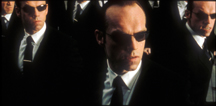
This cultural obsession is inspired by real fears: the AIDS virus, germ warfare, biological terrorism, foot-and-mouth disease, Mad Cow disease, the West Nile virus, and SARS (Severe Acute Respiratory Syndrome). “Ours is an age of viruses,” writes Peter Radetsky in Invisible Invaders (1991). "For most of us, most of the time, viruses are nothing more or less than a great menace. And there's simply no escaping them. Viruses cause more sickness than anything else on earth." Human beings – even as they evolve into posthumanity - may be losing the battle against infectious diseases.
Given our susceptibility to physical illness and our obsession with viral horror, technophiles take refuge in electronic dreams of transferring their minds to computers, robots or even spaceships that might transport them to the stars, far away from this infected planet. But electronic mind transfer into a techno-heaven within a cyber-network provides no safe haven. A computer virus, like an electronic form of Ebola, could spread from machine to machine, chewing up personality patterns and crashing digital bodies. "Humans and computers are both prey to these parasitic forms of life," says Philip Kerr, author of The Second Angel, a techno-thriller set in a post-plague future when an intelligent computer virus alters human evolution. "It’s something we share. Since both types of virus work in exactly the same way, a virus provides a kind of nexus between our two lifeforms – the siliceous and the carbonaceous.”
Virus anxiety reflects much more than a fear of organic and electronic horrors. The virus symbolizes technophobia. A malignant virus acts like a machine, incorporating itself into cellular machinery to mechanically reproduce. Mark Dery, in The Pyrotechnic Insanitarium (1999), adds, "Intriguingly, a prominent subtext of the viral nightmares of the late 20th century is the anxieties spurred by out-of-control technological change . . ."
Most science fiction, as we will see, projects a pessimistic vision of posthuman technology as an autonomous force that strengthens an anti-human, destructive and repressive social milieu. Yet the realization of oppression can spur action. Rather than promoting submissive surrender to a dangerous inevitable posthuman future, science fiction encourages questions about the nature of technology and its unbridled expansion fueled by religious propaganda, military objectives, and corporate profit-making. Science fiction helps us understand the magnitude of the techno-totalitarian threat so we might invent tactics for confronting it.